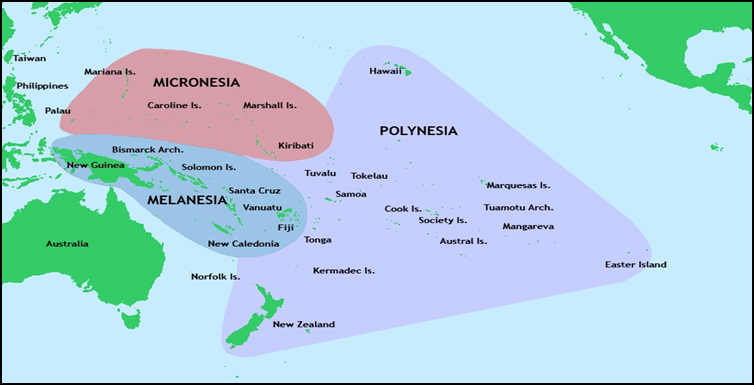In News:
- The US and its allies — Australia, New Zealand, Japan and the United Kingdom — have launched a new initiative called ‘Partners in the Blue Pacific’.
- This has been launched for effective and efficient cooperation with the Pacific Island Nations.
What’s in Today’s Article:
- Pacific Island Nations
- Partners in the Blue Pacific
Pacific Island Nations

- Islands of the Pacific Ocean are commonly named as Pacific Island Nations.
- As shown in the map, Pacific Island Nations consist of three major groups of islands named as Polynesia, Micronesia and Melanesia.
- North of the Equator and east of the Philippines are the islands of Micronesia.
- The great arc of islands located north and east of Australia and south of the Equator is called Melanesia.
- In the eastern Pacific, largely enclosed within a huge triangle formed by the Hawaiian Islands to the north, New Zealand to the southwest, and Easter Island (Rapa Nui) far to the east, are the islands of Polynesia.
Partners in the Blue Pacific (PBP)
- The PBP is a five-nation “informal mechanism” to support Pacific islands and to boost diplomatic, economic ties in the region.
- The initiative speaks of enhancing “prosperity, resilience, and security” in the Pacific through closer cooperation.
- It simply means that through the PBP, these countries — together and individually — will direct more resources here to counter China’s aggressive outreach.
- The members of this initiative have also declared that they will elevate Pacific regionalism, and forge stronger ties with the Pacific Islands Forum.
Areas of cooperation
- The areas where PBP aims to enhance cooperation include –
- climate crisis;
- connectivity and transportation;
- maritime security and protection;
- health, prosperity; and
Rationale behind this initiative
- Intensified geostrategic competition in the region
- China is aggressively pushing to increase its Pacific sphere of influence.
- Recently, China made the projected scope of its growing footprint clear by pushing for a sweeping, common cooperation agreement with 10 Pacific nations.
- In May 2022, China pushed for a sweeping agreement with 10 Pacific nations covering everything from security to fisheries.
- Western countries are fearful that China could be laying the groundwork for an eventual military presence in the region.
- China, Solomon Islands sign landmark security agreement
- In April 2022, China and Solomon Islands signed an inter-governmental framework agreement on security cooperation.
- It was a first-of-its-kind arrangement that could pave the way for further Chinese security deals overseas.
- The deal flagged serious concerns about the Chinese military getting a base in the southern Pacific, close to the US island territory of Guam, and right next to Australia and New Zealand.
- This deal was seen as Beijing’s quest to dominate crucial shipping lanes criss-crossing the region.
- Strategic importance of Pacific region
- In its 2019 strategy report, the US Department of Defence called the Indo-Pacific the single most consequential region for America’s future.
- Spanning a vast stretch of the globe from the west coast of the United States to the western shores of India, the region is home to:
- the world’s most populous state (China),
- most populous democracy (India), and
- largest Muslim-majority state (Indonesia), and
- includes over half of the earth’s population.
- Among the 10 largest standing armies in the world, 7 reside in the Indo-Pacific; and 6 countries in the region possess nuclear weapons.
- Nine of the world’s 10 busiest seaports are in the region, and 60 percent of global maritime trade transits through Asia.
- Roughly one-third of global shipping passing through the South China Sea alone.
Steps taken by US and its allies to counter China
- Launch of Indo-Pacific Economic Framework for Prosperity (IPEF)
- Before launching the PBP this month, the US and its partners started the Indo-Pacific Economic Framework for Prosperity (IPEF).
- IPEF is a trade-boosting play in the region with 13 nations as partners.
- These 13 nations are: Australia, Brunei, India, Indonesia, Japan, Malaysia, New Zealand, the Philippines, Singapore, South Korea, Thailand, Fiji and Vietnam.
- Partnership for Global Infrastructure and Investment (PGII)
- 48th G7 summit at Germany announced a plan —PGII — to rival China’s Belt and Road Initiative.
- It promises to raise $600 billion to fund development projects in low and middle-income countries.
- Maintained a balance of power in the region with its hub-and-spoke system
- The US has long maintained a balance of power in the region with its hub-and-spoke system.
- In this system, America is the hub and its allies are spokes whose security is guaranteed by the US military power.










